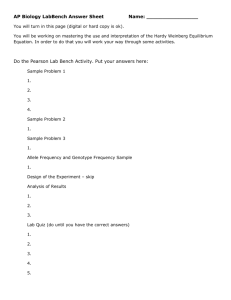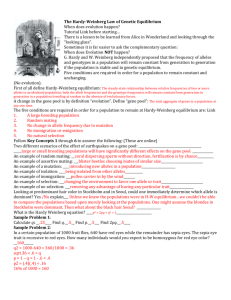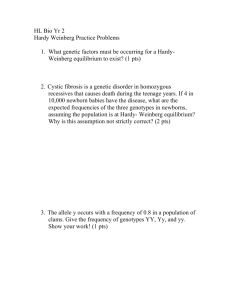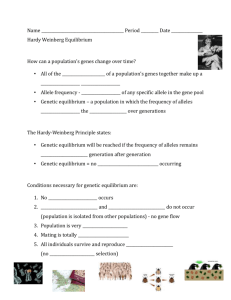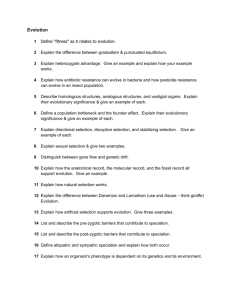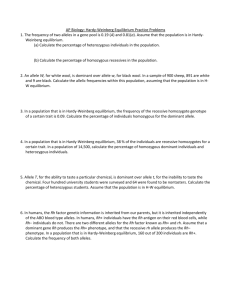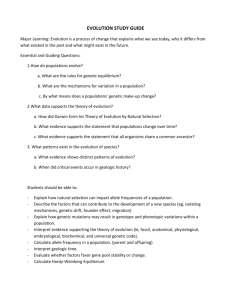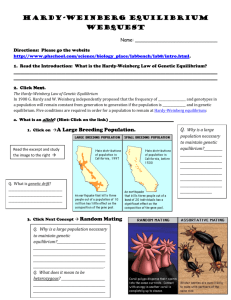The Hardy-Weinberg Law of Genetic Equilibrium When does
advertisement
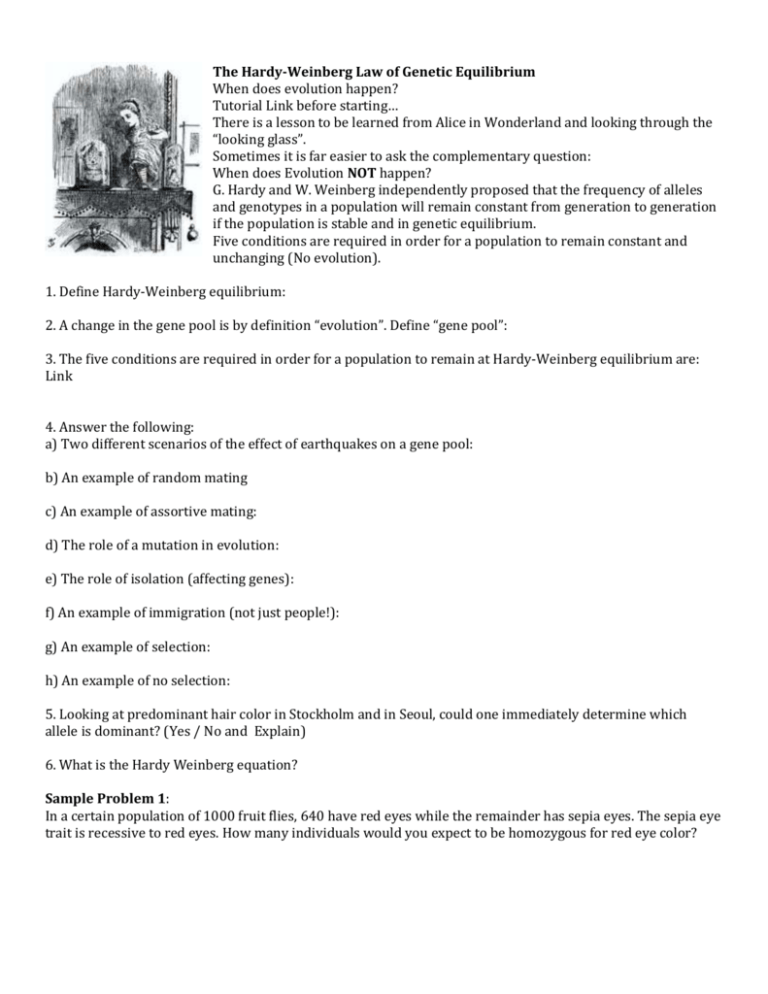
The Hardy-Weinberg Law of Genetic Equilibrium When does evolution happen? Tutorial Link before starting… There is a lesson to be learned from Alice in Wonderland and looking through the “looking glass”. Sometimes it is far easier to ask the complementary question: When does Evolution NOT happen? G. Hardy and W. Weinberg independently proposed that the frequency of alleles and genotypes in a population will remain constant from generation to generation if the population is stable and in genetic equilibrium. Five conditions are required in order for a population to remain constant and unchanging (No evolution). 1. Define Hardy-Weinberg equilibrium: 2. A change in the gene pool is by definition “evolution”. Define “gene pool”: 3. The five conditions are required in order for a population to remain at Hardy-Weinberg equilibrium are: Link 4. Answer the following: a) Two different scenarios of the effect of earthquakes on a gene pool: b) An example of random mating c) An example of assortive mating: d) The role of a mutation in evolution: e) The role of isolation (affecting genes): f) An example of immigration (not just people!): g) An example of selection: h) An example of no selection: 5. Looking at predominant hair color in Stockholm and in Seoul, could one immediately determine which allele is dominant? (Yes / No and Explain) 6. What is the Hardy Weinberg equation? Sample Problem 1: In a certain population of 1000 fruit flies, 640 have red eyes while the remainder has sepia eyes. The sepia eye trait is recessive to red eyes. How many individuals would you expect to be homozygous for red eye color? Sample Problem 2: Phenylketonuria (PKU) is a human metabolic disorder that results in mental retardation if it is untreated in infancy. In the United States, one out of approximately 10,000 babies is born with the disorder. Approximately what percent of the population are heterozygous carriers of the recessive PKU allele? __________ 2b) Homozygous individuals stricken with PKU never have children. List any Hardy-Weinberg Equilibrium condition(s) not being met with the PKU example cited above. Sample Problem 3: Let’s compare two Mugwump populations which inherit coat color accordingly: BB is bronze, Bb is speckled (excellent camouflage against lichen) and bb is white. An isolated population has 10 000 individuals: 3600 Bronze - 4800 Speckled - 1600 White ; for a total of 10 000 in the population A different isolated population also has 10 000 individuals 3000 Bronze – 6000 Speckled – 1000 White ; again for a total of 10,000 individuals. First Population: p = & q= Second Population: p = & q= 3b) One population is in HW equilibrium, while the other population is decidedly NOT in Hardy-Weinberg Equilibrium. Identify which is which. The first / second population is in Hardy Weinberg Equilibrium. Explain (circle one) The first / second population is NOT in Hardy Weinberg Equilibrium. Explain (circle one) 3c) Provide a possible explanation why one population is not in Hardy Weinberg Equilibrium. Sample Problem 4: Homozygous recessive sickle cell anaemia is lethal and stricken individuals rarely have children. Yet in some regions of the world, the frequency of the sickle cell allele (q) is increasing over time. Why would that be? Explain. 3b) In other regions of the world, the frequency of the sickle cell allele (q) is remaining constant over time. Does unchanging p & q constancy indicate Hardy Weinberg Equilibrium has been achieved? Explain. 3c) What about Sickle Cell Anemia North America? Is p & q for Sickle Cell Anemia changing in North America? Explain. Allelic Frequency vs. Genotypic Frequency: 1. If you are told that the frequency of a recessive allele in a population is 10%, what is q for this population? 2. If you observe a population and find that 16% show the recessive trait, you know the frequency of the aa genotype. This means you know q2. What is q for this population? 3. A class of 12 AP biology students gathered the following data: Initial class frequencies: AA 3 Aa 6 aa 3 Final class frequencies: AA 2 Aa 5 aa 5 1. What are the initial p and q? 2. What are the final p and q? 3. Is the population in Hardy-Weinberg equilibrium? Explain your response. 4. Four evolutionary pressures that cause populations to change: 5. Two causes of “Genetic Drift” would be: 6. Natural selection changes allele frequency, and therefore the accumulation of favorable traits, in three ways:
